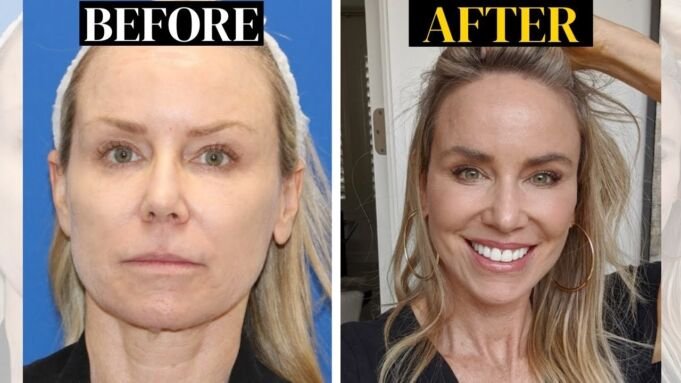In the realm of cosmetic enhancements, where innovation constantly reshapes possibilities, the Vertical Restore Facelift emerges as a pioneering procedure promising a harmonious blend of natural rejuvenation and minimal downtime.
This groundbreaking approach has captivated attention for its ability to precisely target aging concerns, offering individuals a refreshed appearance with subtlety and finesse.
Embarking on a journey to demystify the Vertical Restore Facelift, we delve into its intricacies, methodology, advantages, and frequently asked questions to equip you with the knowledge needed to make informed decisions about your aesthetic goals.
If you want to know more about vertial restore facelift you can visit Azurite Medical & Wellness.
What is a Vertical Restore Facelift?
1. Understanding the Vertical Restore Facelift:
Defining Vertical Restore Facelift: At its core, the Vertical Restore Facelift is a specialized cosmetic procedure designed to address signs of aging in a targeted manner, focusing on restoring facial contours and enhancing overall youthfulness.
Distinguishing Features: What sets the Vertical Restore Facelift apart from conventional facelift techniques is its emphasis on vertical lifting, which allows for a more natural and long-lasting outcome.
2. The Science Behind Vertical Restore Facelift:
Facial Aging Dynamics: Before delving into the procedure, it’s crucial to understand the underlying mechanisms of facial aging, including factors such as loss of volume, skin laxity, and gravitational effects.
Targeted Rejuvenation: The Vertical Restore Facelift employs advanced techniques to address specific aging concerns, such as sagging skin, jowls, and deep creases, with precision and effectiveness.
3. Advantages of Vertical Restore Facelift:
Subtle and Natural Results: Unlike traditional facelifts that may yield a more pulled or artificial appearance, the Vertical Restore Facelift aims to deliver results that appear refreshed and rejuvenated, yet undeniably natural.
Minimal Downtime: With its focus on vertical lifting and strategic tissue repositioning, the Vertical Restore Facelift often boasts shorter recovery periods compared to traditional facelift procedures, allowing individuals to return to their daily activities sooner.
4. Candidacy for Vertical Restore Facelift:
Ideal Candidates: While the Vertical Restore Facelift is suitable for a wide range of individuals seeking facial rejuvenation, ideal candidates typically exhibit mild to moderate signs of aging and have realistic expectations about the outcome.
Considerations: Factors such as overall health, skin quality, and lifestyle habits are taken into account when determining candidacy for the procedure.
5. The Vertical Restore Facelift Procedure:
Step-by-Step Overview: From initial consultation to post-operative care, each phase of the Vertical Restore Facelift is meticulously planned and executed to ensure optimal results and patient satisfaction.
Anesthesia Options: Depending on individual preferences and the extent of the procedure, anesthesia options may include local anesthesia with sedation or general anesthesia for added comfort.
6. Recovery Journey and Post-procedural Care:
Navigating Recovery: Following the Vertical Restore Facelift, patients are guided through the recovery process, which typically involves managing swelling, bruising, and discomfort in the initial days and weeks post-procedure.
Long-term Care: Adopting a comprehensive post-operative care regimen, including gentle skincare, sun protection, and regular follow-up appointments, is essential for maintaining and maximizing results over time.
7. Risks and Potential Complications:
Understanding Risks: While the Vertical Restore Facelift is generally considered safe when performed by a skilled and experienced surgeon, potential risks and complications may include infection, hematoma, nerve injury, or unfavorable scarring.
Risk Mitigation: Strategies such as thorough pre-operative screening, adherence to surgical protocols, and diligent post-operative care help minimize the likelihood of complications and ensure optimal outcomes.
8. Cost Considerations:
Factors Influencing Cost: The total cost of a Vertical Restore Facelift may vary depending on factors such as geographic location, surgeon expertise, facility fees, anesthesia expenses, and any additional procedures or treatments included.
Financial Planning: Exploring financing options, such as payment plans or medical financing programs, can help make the Vertical Restore Facelift more accessible to individuals seeking cosmetic enhancement.
9. Vertical Restore Facelift vs. Other Facial Rejuvenation Procedures:
Comparative Analysis: Contrasting the Vertical Restore Facelift with alternative rejuvenation techniques, including Botox, dermal fillers, and traditional facelifts, highlights the unique benefits and considerations of each approach.
Tailored Solutions: Depending on individual needs and aesthetic goals, a customized treatment plan may involve a combination of procedures to achieve optimal results.
10. Testimonials and Real-life Experiences:
Personal Accounts: Hearing from individuals who have undergone the Vertical Restore Facelift firsthand provides valuable insight into their experiences, expectations, and outcomes.
Visual Documentation: Before-and-after photos showcase the transformative effects of the Vertical Restore Facelift, illustrating the potential for rejuvenation and enhancement.
Frequently Asked Questions (FAQs):
What is the typical duration of a Vertical Restore Facelift procedure?
The duration of a Vertical Restore Facelift procedure can vary depending on factors such as the extent of correction needed and whether additional procedures are being performed simultaneously. On average, the procedure typically takes between two to four hours to complete.
How long can one expect the recovery phase to last following a Vertical Restore Facelift?
The recovery period following a Vertical Restore Facelift varies from individual to individual but generally ranges from one to two weeks. During this time, patients may experience mild swelling, bruising, and discomfort, which gradually subside as the healing process progresses.
Are there any age restrictions for undergoing the Vertical Restore Facelift?
While there are no strict age restrictions for undergoing a Vertical Restore Facelift, ideal candidates typically exhibit mild to moderate signs of aging and have realistic expectations about the outcome. The suitability for the procedure is assessed on a case-by-case basis during a consultation with a qualified cosmetic surgeon.
Will the results of a Vertical Restore Facelift appear natural?
Yes, one of the key advantages of the Vertical Restore Facelift is its ability to deliver natural-looking results. By focusing on vertical lifting and tissue repositioning, the procedure aims to restore youthful contours without imparting a pulled or overly tight appearance to the face.
Can the Vertical Restore Facelift be combined with other cosmetic procedures?
Yes, the Vertical Restore Facelift can be combined with other cosmetic procedures to address additional aesthetic concerns and achieve comprehensive rejuvenation. Common complementary procedures include eyelid surgery, brow lift, or non-surgical treatments such as Botox or dermal fillers.
Is discomfort experienced during or after the Vertical Restore Facelift procedure?
While discomfort during the Vertical Restore Facelift procedure is minimized through the use of anesthesia, some patients may experience mild discomfort or tightness in the treated areas during the initial stages of recovery. Pain medication and other post-operative measures are provided to manage any discomfort effectively.
What is the typical duration of results obtained from a Vertical Restore Facelift?
The results of a Vertical Restore Facelift are long-lasting, with many patients enjoying the benefits of the procedure for five to ten years or more. However, it’s essential to understand that the aging process continues over time, and individual results may vary.
What are the potential risks or complications associated with the Vertical Restore Facelift?
Like any surgical procedure, the Vertical Restore Facelift carries potential risks and complications, although they are rare when performed by a skilled and experienced surgeon. Possible risks include infection, bleeding, adverse reaction to anesthesia, nerve injury, or unfavorable scarring.
When can individuals resume regular activities following a Vertical Restore Facelift?
The timing for resuming regular activities following a Vertical Restore Facelift varies depending on individual healing and the extent of the procedure. While most patients can return to light activities within a few days, it’s advisable to avoid strenuous exercise and heavy lifting for at least two to four weeks.
Is the Vertical Restore Facelift suitable for both men and women?
Yes, the Vertical Restore Facelift is suitable for both men and women seeking facial rejuvenation. The procedure can be customized to address specific concerns and aesthetic goals unique to each patient, regardless of gender. During a consultation, the cosmetic surgeon will tailor the treatment plan to meet the individual needs of the patient.
Conclusion:
In the pursuit of timeless beauty and self-confidence, the Vertical Restore Facelift emerges as a beacon of hope, offering individuals a transformative journey towards rejuvenation with precision and artistry.
By unraveling the complexities of this innovative procedure, individuals gain a deeper understanding of its methodology, benefits, and considerations, empowering them to make informed decisions about their aesthetic aspirations.
With the guidance of experienced cosmetic surgeons and a comprehensive grasp of the Vertical Restore Facelift, individuals can embark on a path towards renewed vitality and confidence, embracing the endless possibilities of self-transformation.














